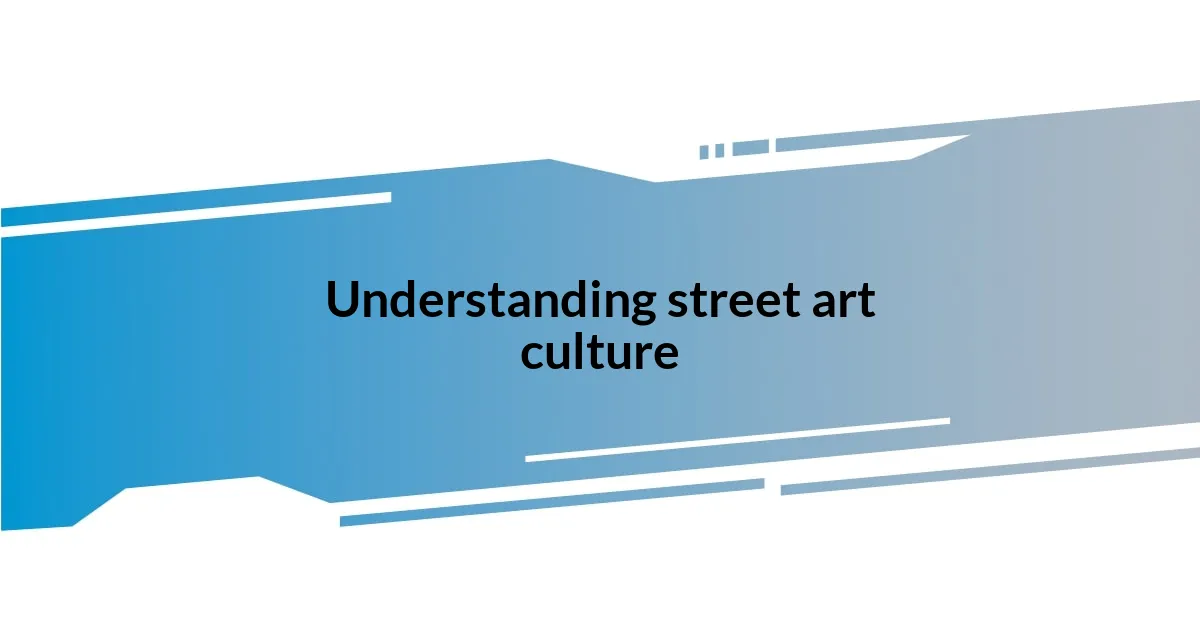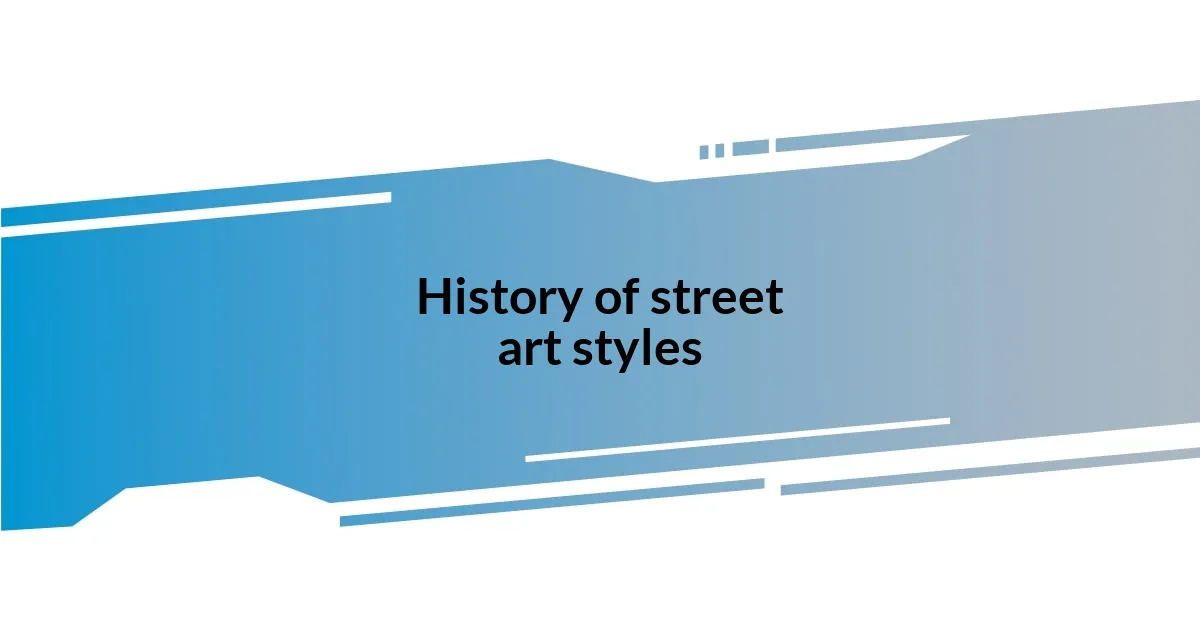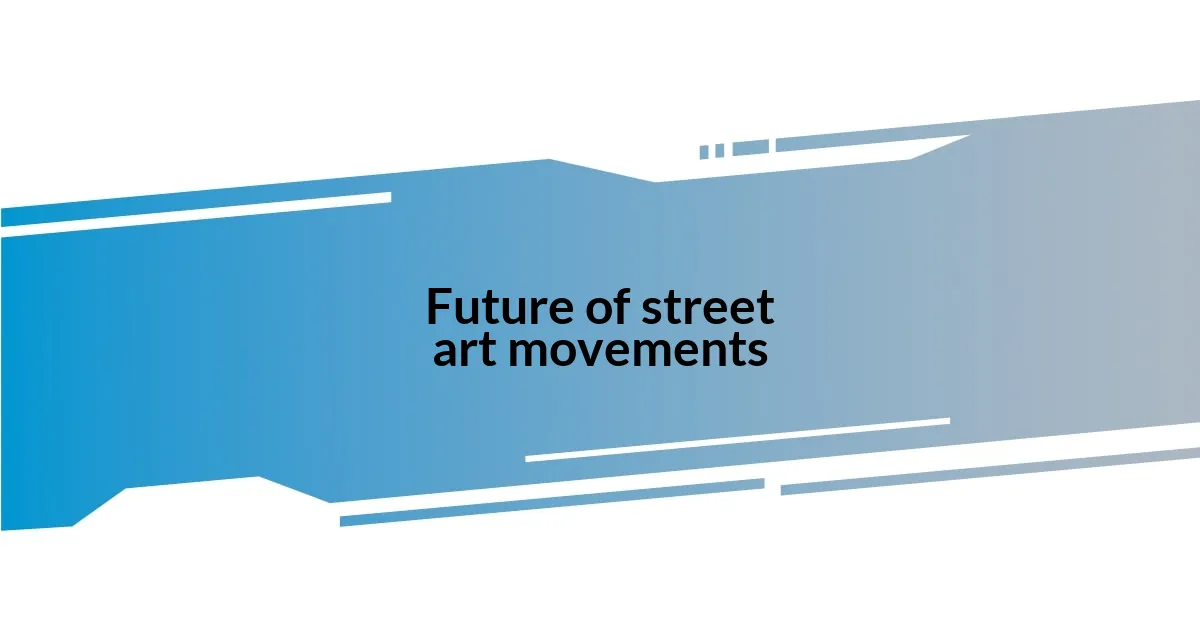Key takeaways:
- Street art serves as a powerful medium for socio-political expression, often reflecting community struggles and emotions that words cannot convey.
- The evolution of street art techniques—from graffiti to stenciling and murals—highlights its role in engaging public dialogue and raising awareness about contemporary issues.
- The future of street art is poised to embrace technology and collaborative community projects, promoting diverse narratives while navigating the balance between artistic integrity and mainstream acceptance.

Understanding street art culture
Street art culture is a fascinating blend of creativity, rebellion, and community expression. I remember walking through a city once, my eyes drawn to a vibrant mural that transformed a dull wall into a storytelling canvas. How incredible is it that such artwork can spark conversations and even inspire movements?
As I delve into street art, I can’t help but think about its roots; it often emerges from socio-political contexts where artists feel the need to voice their feelings. I once stood in front of a piece that depicted a struggle for freedom, and it hit me deeply. Isn’t it powerful how art can carry the weight of emotions and ideas that words sometimes fail to express?
The culture surrounding street art is also about connection—between the artist and the observer, and among fellow admirers. I often find myself sharing thoughts with strangers as we pause to appreciate a piece together. Isn’t that what art is supposed to do—bring people together in shared understanding and appreciation?

History of street art styles
Street art has a rich and varied history that reveals different styles and movements. In the late 20th century, graffiti emerged as a primary form, often tied to hip-hop culture and urban youth. I recall vividly the first time I realized that graffiti wasn’t just vandalism; seeing a tag evolve into a breathtaking mural opened my eyes to the artistic expression behind it.
As the years progressed, street art began to incorporate various styles such as stenciling and wheatpasting, which allowed artists to craft more detailed and thought-provoking pieces. When I stumbled upon a stenciled portrait on a busy city street, the intricate layers and the story it told resonated with me. It made me question how artists use this accessibility to challenge societal norms and engage the public directly.
Today, the styles of street art range from bold and abstract to intricate and realistic, often reflecting contemporary issues. I can’t forget the awe I felt standing before a massive mural that portrayed climate change, uniting stunning imagery with a critical message. It made me ponder the powerful role of street art in sparking awareness and driving change.
| Style | Description |
|---|---|
| Graffiti | A colorful form of writing or drawing, often seen as a form of rebellion. |
| Stenciling | Using templates for sharp, defined images, often carrying political or social messages. |
| Wheatpasting | Adhering printed paper art to surfaces, providing a way to share intricate designs. |
| Murals | Large, painted artworks that beautify urban spaces and reflect local communities. |

Personal experiences with street art
I remember the first time I discovered a hidden alley adorned with colorful street art. As I turned the corner, I was completely taken aback by the sheer vibrancy of the pieces that lined the walls. Each stroke seemed to breathe life into the space, and I couldn’t help but feel a surge of joy. It’s fascinating how these artworks create unexpected moments of beauty in everyday life.
- I’ve found that street art often reflects the spirit of the neighborhood it’s in, with each piece telling a unique story.
- Encountering a mural that featured local legends sparked a sense of pride and connection to my community.
- Once, while taking a casual stroll, I stumbled upon a piece that eerily mirrored my own life experiences, making me feel seen and understood.
- Conversations with fellow art enthusiasts in front of these pieces often lead to deeper discussions about identity and culture.
- I’ve even participated in a street art tour, where the guide shared personal stories about the artists, turning the viewing into an intimate experience of shared humanity.
Sometimes, it’s the simplest moments that leave the greatest impact. I once spent an afternoon photographing street art in my city, feeling like a tourist in my own home. Each click of the camera felt like capturing a fleeting thought or emotion. It truly amazed me how street art serves as a documented timeline of a community’s narrative, reflecting changes over time.

Techniques used in street art
Street artists employ a variety of techniques that transform ordinary spaces into vibrant canvases. I remember coming across an artist furiously spraying paint onto a brick wall, deftly layering colors to create a stunning 3D effect. The depth in that piece made me wonder—how much planning goes into a spontaneous-looking work? The careful choreography of spray can and brush is mesmerizing and often reflects the artist’s intent to engage with viewers in an immersive experience.
Stenciling is another fascinating technique that captures my attention. I once observed a whole series of politically charged stencils that told a compelling story about social justice. Each image felt like a conversation starter, detailing issues that often remain hidden. It made me realize how accessible this form of art is—the artist can convey a powerful message quickly, allowing them to have an impact in a matter of days or even hours.
Wheatpasting also deserves a shoutout. I have fond memories of slowly peeling layers off washed-out posters filled with vibrant designs in an urban neighborhood I frequented. The process of layering adds texture and often weaves together different narratives. It fascinates me how these pasted artworks can be both ephemeral and permanent, echoing the fleeting nature of our daily lives while leaving a lasting footprint on the environment. What do you think—does the temporary nature of wheatpasting add to its allure? In my experience, it does; the experience of discovering something new and unexpected always feels thrilling.

Discussing street art ethics
Navigating the ethics of street art feels like walking a fine line between expression and legality. I recall a time when a local artist painted a gorgeous mural on an abandoned building, capturing the attention of everyone in the neighborhood. While many praised the art, the owner of the building later expressed discontent, emphasizing the need for permission. This clash made me ponder—does the beauty of art justify the lack of permission? In my view, it signals the necessity for dialogue and consent in public spaces.
It’s equally essential to address the themes portrayed in street art. I once stumbled upon a powerful piece addressing mental health, surrounded by tags of support from the community. It sparked a debate among friends: Should street artists have the liberty to address controversial issues, even if they disrupt the status quo? I firmly believe that art can be a catalyst for important conversations, yet I also recognize that sensitivity to context is crucial. Art should provoke thought, but it shouldn’t alienate or misrepresent the voices within that community.
Additionally, I find that some elements of street art can inadvertently reflect social inequalities. There’s an instance I vividly remember, where a provocative artwork sparked outrage among some locals while resonating deeply with others. This situation opened my eyes to the often overlooked power dynamics in art. How do we ensure that all voices are included in this urban gallery? In my experience, fostering an environment where diverse stories are told is essential—after all, street art should serve as a reflection of the community’s multifaceted nature.

Future of street art movements
The future of street art movements excites me as we enter an era dominated by technology. I remember one evening wandering through a city where projections of digital art lit up empty walls, transforming them into dynamic canvases. This intersection of technology and street art opens up avenues for virtual galleries, where artists can still make their mark without the constraints of physical space. Isn’t it intriguing how the medium itself is evolving?
As street art gains recognition in galleries and institutions, there’s a real possibility of mainstream acceptance. I often think about how local artists I’ve followed over the years might feel about their work being showcased in a more traditional setting. Will this commercial success dilute their raw edge and spontaneous charm? I believe it’s vital to maintain that authentic voice, even if it means navigating the complexities of the art market.
Moreover, I see a movement toward more collaborative projects that reflect community voices. I fondly recall a community mural project I participated in, where diverse groups came together to create a piece that was truly a tapestry of our neighborhood. This collective approach not only fosters connection but also amplifies underrepresented narratives. How can we elevate this collaborative spirit in the future? From my perspective, harnessing local stories through street art will undoubtedly create a more reflective and inclusive urban landscape.
